History and Big Steps
1850-1900:
1. Francis Galton – Father of Psychometrics and So Many Other Things…
1900-1950:
2. Charles Spearman and the Discovery of the g Factor
1950-2000:
3. William Shockley and Dysgenics in the United States
4. Hans Eysenck and the Inequality of Man
5. “The Bell Curve” by Hernstein and Murray
2000- :
6. Richard Lynn, a pioneer in the footsteps of Francis Galton
7. Jean-Philippe Rushton and the r/K Zoologic Gradient
8. Tatu Vanhanen and the Political Implications of Racial Differences
9. Arthur Jensen and the Study of the g Factor
10. The courage of James Watson
11. Helmuth Nyborg and the Hormonal Influences
12. Linda Gottfredson and the social importance of intelligence variations
13. Robert Plomin and the emergence of GWAS scores
14. Emil Kirkegaard, Young, Gifted, Workaholic… Future Is Assured
1. Francis Galton – Father of Psychometrics and So Many Other Things…

First steps…
“I propose to show in this book that a man’s natural abilities are derived by inheritance, under exactly the same limitations as are the form and physical features of the whole organic world.”
A genius polymath with an IQ estimated at 200 (Terman, 1917a)—the same as Blaise Pascal (Cox, 1926)—Francis Galton was the cousin of Charles Darwin, with whom he shared a maternal grandfather, Erasmus Darwin. With his pupil and later best friend, Karl Pearson, he developed nearly all of the Western statistical methods still used today in modern analysis. He discovered ultrasound, made major contributions to meteorology (introducing terms like “anticyclone”), and in criminology, pioneered the use of fingerprints for identification.
Galton also laid the foundation for current morphing techniques, was an explorer and geographer, wrote bestsellers, and even invented the sleeping bag. He is considered the father of differential psychology and one of the greatest geneticists of his era. In 1909, he was knighted for his “invaluable contribution to human knowledge.”
However, he was not the first to develop the concept of eugenics (even though he coined the term); as early as 380 B.C., Plato outlined its foundations in The Republic, imagining a utopian state based on selective breeding.
Portrait: Sir Francis Galton aged 18 in 1840
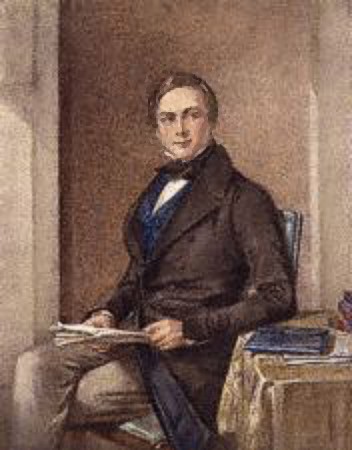
Hereditary Genius is a seminal work that marked its era, much like The Origin of Species by his cousin Charles Darwin. Its heritability estimates of intelligence remain remarkably accurate in light of current research. Hereditary Genius was prominently featured in Nietzsche’s private library.
Galton had many remarkable intuitions.
In Hereditary Genius, he demonstrates the highly genetic nature of human intelligence and provides heritability estimates that, with only a few nuances, closely match those obtained through modern biotechnological methods. He also applies the “law of deviation from the mean” to what he calls “general cognitive ability.”

Law of Deviation from the Average – Hereditary Genius (1869)
According to Galton, general cognitive ability distribution follows a Gaussian curve—just like human stature. He established distinct degrees of intelligence along this curve.
Below is Galton’s proposed distribution of intelligence. Upper-case letters represent above-average intelligence, while lower-case letters indicate below-average intelligence. Each grade corresponds to approximately 10.425 IQ points. Grade A represents an IQ of about 105, while grade G corresponds to an IQ of approximately 170.

Law of Deviation from the Average – Hereditary Genius (1869)
The distribution of general cognitive ability is represented as a Gaussian curve, much like human height. Galton established distinct degrees of intelligence along this curve.
Here is the distribution of intelligence according to Galton. Upper-case letters indicate above-average grades, while lower-case letters indicate below-average grades. Each grade represents approximately 10.425 IQ points. Grade A is centered around an IQ of 105, while grade G corresponds to a value of approximately 170.
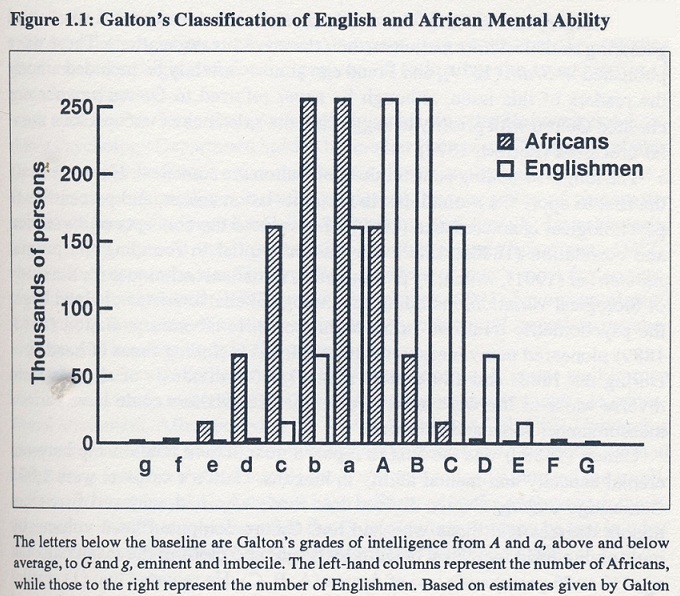
Galton’s Intelligence Grades
Each grade is separated by approximately 10.425 IQ points.
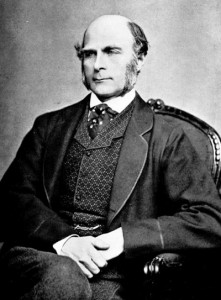
To learn more about Francis Galton, visit the excellent site galton.org
2. Charles Spearman and the Discovery of the g Factor
Charles Spearman (1863–1945) is credited with the empirical validation of Galton’s intuitions. He studied children’s school performance at the time and observed that those who received good marks in certain subjects tended to perform well in all subjects, while those who struggled in some areas generally performed poorly across the board.
Spearman was particularly interested in the fact that hearing discrimination tests also seemed to correlate with other cognitive assessments. These tests involved playing two different sound frequencies for children and asking them which sound was higher in pitch. The frequencies were then brought progressively closer together to determine the fineness of auditory discrimination.
To analyze these patterns, Spearman developed a method called factor analysis, which enabled him to identify a single underlying factor influencing performance across diverse cognitive tasks. He called this factor g, short for general intelligence.
Spearman discovered that a large proportion of so-called “intellectual faculties” is supported by this single, underlying factor. Factor g is a biological, organic, and individual trait that underlies all cognitive processes passing through the central nervous system—in other words, it is involved in all general cognitive functions.
Factor g reflects the overall efficiency of the central nervous system.
The g factor (also known as Spearman’s g) is measured in IQ units and is typically what is extracted from a standard battery of intelligence tests.

Illustrating the g factor
Spearman studied the school performance of children at the time and observed that those who achieved high marks in certain subjects tended to perform well across all subjects, while those who struggled in some areas generally performed poorly in others as well.
He was particularly intrigued by the observation that hearing discrimination tests also appeared to correlate with other cognitive assessments. In these tests, two children would listen to tones of different frequencies and indicate which sound was higher in pitch. The frequency difference would then be gradually reduced to determine the precision of their auditory discrimination.
To make sense of these correlations, Spearman developed a statistical method known as factor analysis, which allowed him to extract a common underlying element from a range of cognitive tasks. He called this element the g factor, short for general intelligence.
The phenomenon of consistent positive intercorrelations among various mental abilities—referred to as the positive manifold—has been described as “probably the most replicated result in all of psychology” (Deary, 2000).
This web of intercorrelations allows researchers to extrapolate a single value from a battery of tests: the IQ score, which is far more than just an “average of disparate results.”
Spearman also argued that group differences—particularly those observed between racial groups, such as between African and European populations—are primarily differences in g.
For a more in-depth exploration of the g factor, see the article FAQ: Intelligence.
3. William B. Shokley and Dysgenics in the United States
William Shockley (1910–1989) was awarded the Nobel Prize in Physics for his role in the invention of the transistor. He is also known as the father of Silicon Valley and is considered one of the most influential figures of the 20th century for helping to usher in the electronics era.

William Shockley – Nobel Prize in Physics for the Invention of the Transistor
William Shockley (1910–1989) was awarded the Nobel Prize in Physics for his co-invention of the transistor—an achievement that revolutionized electronics and laid the foundation for modern computing. He is often regarded as one of the key figures in the creation of Silicon Valley.
Later in life, Shockley turned his attention to studying human intelligence. Convinced of a strong genetic basis for IQ, he became a vocal and controversial advocate for what he believed were the eugenic implications of intelligence research. Shockley expressed concern over demographic trends in the United States, claiming that higher birth rates among African Americans could, in his view, negatively affect the nation’s average intelligence. He stated, “African Americans have an inextricably lower intelligence—about 15 percent lower [than that of Europeans]. I have been studying these issues for years and consider that my efforts to raise awareness of these fundamentals are more important than my contribution to physics.”
Shockley also coined and popularized the term “dysgenics” intended as the opposite of “eugenics“ to describe what he believed was a decline in the genetic quality of populations due to differential birth rates.
His views sparked intense public backlash and academic criticism. Like many others who have engaged with the politically sensitive subject of group differences in intelligence, Shockley became a polarizing figure, facing both condemnation and support. His work in this area is widely regarded today as highly controversial and remains the subject of ethical, scientific, and social debate.
A notable moment in this debate was his 1974 televised discussion on racial differences in intelligence quotient (IQ), which drew national attention and further fueled the controversy.
4. Hans Eysenck and “The Inequality of Man”

One of Hans Eysenck’s best-selling works is The Inequality of Man, in which he explores the significance of intellectual differences between individuals and the role of IQ in determining social achievement. He emphasizes the cognitive disparities observed between social classes, as well as between European and African-American populations. Drawing on studies of monozygotic (identical) twins, Eysenck argues that intelligence is highly heritable. He cites findings that place the average IQ of Europeans at around 100, and that of African-Americans at approximately 85.
In the book, Eysenck also challenges the claim that IQ tests are culturally biased, pointing out that individuals of East Asian descent often perform as well as—or better than—Europeans on standard intelligence tests.
Due to his controversial positions, Eysenck faced significant public backlash. He was physically attacked while beginning a lecture at the London School of Economics—an example of the hostility directed at scholars who addressed sensitive topics in human intelligence research.

The Inequality of Man, Eysenck, 1973
A few years earlier, in his book The I.Q. Argument (1971), Eysenck argued that the consistently lower scores of African Americans on cognitive tests were largely attributable to genetic factors. He concluded that these differences in average IQ were a key explanation for disparities in social and academic achievement between European and African-American populations.
The I.Q. Argument, Eysenck, 1971
5. The Bell Curve by Hernstein and Murray
In 1994, Harvard sociology professor Richard Herrnstein and political scientist Charles Murray published a bestselling book titled The Bell Curve. The book shows that differences in income and socio-economic status among Europeans, Hispanics, and African Americans are largely due to differences in intelligence. It also suggests that, when IQ is controlled for, average wages across these groups are essentially equivalent—implying that disparities in outcomes are primarily the result of intelligence differences.
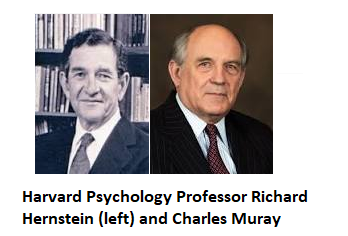
It might have been hoped that, following Herrnstein and Murray’s demonstration that intellectual differences between racial groups contribute significantly to disparities in wages, socio-economic status, education, and other social outcomes, sociologists—many of whom had long attributed these differences to cultural factors or systemic discrimination by Europeans—would revise their views and adopt this new paradigm. Some did acknowledge the findings. For example, Darity and Myers (1998) concluded that “when controlling for IQ differences, all wage disparities between Europeans and African Americans are eliminated.”
However, history shows that new theories which challenge deeply held and culturally significant beliefs are often ignored or subtly dismissed. Many sociologists criticized The Bell Curve, yet none successfully refuted its central thesis.

The Bell Curve: Intelligence and Class Structure in American Life, Richard J. Herrnstein & Charles Murray, 1994
6. Richard Lynn, a pioneer in the footsteps of Francis Galton
Richard Lynn, born in 1930, is a psychologist from the University of Cambridge.
He served as Professor of Psychology at the Psychology and Economics Research Institute in Dublin and was also Professor and Head of the Psychology Department at the University of Ulster. Lynn received the Passingham Prize, the Cambridge University award for Best Psychology Student of the Year, and the Mensa Award for Best Research Performance in 1985, 1993, and 2005 for his work on intelligence.
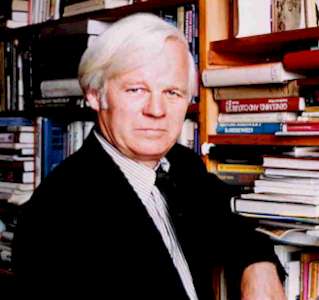
Richard Lynn has made significant contributions to the fields of human intelligence and psychometrics.
He was the first to identify and explain what later became known as the Flynn effect—the steady rise in IQ scores over the past several decades. Lynn attributed this increase largely to improvements in nutrition. The phenomenon was later named after James Flynn, who helped popularize Lynn’s original discovery.
Lynn also investigated cognitive differences between sexes, estimating an average adult male advantage of about 5 IQ points. Additionally, he was among the first, in the 1980s, to highlight the consistently high average IQ of East Asian populations—referred to at the time as “Mongoloid” groups.
In 1994, Lynn began studying what he termed genetic degradation in modern societies. In his book Dysgenics, he compiled a wide range of evidence suggesting that early eugenicists had valid concerns. He argued that, globally, individuals with lower cognitive ability tend to have more children—a trend he attributes largely to differences in contraceptive use and societal patterns.
Lynn also warned of a genotypic decline in traits such as “conscientiousness”, a core dimension in personality psychology. This trend, known as dysgenics or dysgenism—a term originally popularized by Nobel laureate William Shockley—refers to a deterioration in genetic quality due to a decreasing frequency of alleles associated with high intelligence, and a growing frequency of those associated with lower intelligence.

Dysgenics: Genetic Deterioration in Modern Populations, Richard Lynn, 2nd edition, 2011
In 2001, Richard Lynn published Eugenics: A Reassessment, a remarkable and provocative book in which he predicts the future emergence of China as a global superpower. Lynn argues that advances in embryonic selection will soon make it possible to increase the average IQ by approximately 15 points per generation.

Eugenics: A Reassessment, Richard Lynn, 2001
In 2001, Richard Lynn and Tatu Vanhanen published IQ and the Wealth of Nations, in which they demonstrated that approximately 75% of the variation in GDP per capita across countries can be statistically explained by differences in national average IQ. Their data showed a global range, from an average IQ of 59 in Equatorial Guinea to 108 in Singapore. This finding is significant because it suggests a strong biological foundation for economic development. Several sections of the site elaborate on this data, including the chapter IQ by Country and Economy.

IQ and the Wealth of Nations, Richard Lynn & Tatu Vanhanen, 2001
In 2006, Richard Lynn published “Race Differences in Intelligence: An Evolutionary Analysis,” the most extensive compilation of intelligence estimates across major human populations, based on psychometric and genetic data. In this work, Lynn establishes average IQ scores for various racial and ethnic groups, as follows: East Asians (105), Europeans (99), Southeast Asians (87), Native Americans (86), Pacific Islanders (85), North Africans and Middle Easterners (84), Sub-Saharan Africans (67), Bushmen (54), and Great Apes (25).
The book emphasizes the high reliability of these estimates and their strong predictive power for various socio-economic indicators. Lynn also provides an evolutionary framework, tracing the development of intelligence from early mammals through birds and primates, culminating in the genus Homo and its various subspecies.

Race Differences in Intelligence: An Evolutionary Analysis, Richard Lynn, 2006
In 2006, IQ and Global Inequality was published as an updated and expanded version of IQ and the Wealth of Nations. In this work, Richard Lynn and Tatu Vanhanen argue that much of the global variation in social and economic development is underpinned by differences in average IQ between populations and nations. They present extensive data to support the view that national intelligence levels are strong predictors of income, education, health, and political stability.

IQ and Global Inequality, Richard Lynn & Tatu Vanhanen, 2006
In 2008, Richard Lynn published The Global Bell Curve: Race, IQ, and Inequality Worldwide as a tribute to The Bell Curve by Herrnstein and Murray. In this work, Lynn extends their thesis on the role of intelligence in shaping social structure. He demonstrates that, across multi-ethnic countries around the world, social hierarchies tend to align consistently with group differences in average IQ. Regardless of cultural context, Lynn argues, intelligence remains a primary determinant of socio-economic status. For further details, see Worldwide Hierarchy.

The Global Bell Curve: Race, IQ, and Inequality Worldwide, Richard Lynn, 2008
7. Jean-Philippe Rushton and the r/K Zoological Gradient

J. Philippe Rushton applied the r/K selection theory, a concept from evolutionary biology, to the human species. He argued that different populations of Homo sapiens fall along a continuum of reproductive strategies, with Africans being more r-selected (characterized by higher fertility and lower parental investment), Europeans falling in the middle, and East Asians being more K-selected (characterized by lower fertility, greater parental investment, and higher social organization).
See Rushton: An Evolutionary Perspective.

Race, Evolution, and Behavior: A Life History Perspective, J. Philippe Rushton, 2000
Linda Gottfredson and J.P. Rushton

8. Tatu Vanhanen: The Political Consequences of Racial Differences
Tatu Vanhanen is a professor at the University of Tampere, Finland, and the father of Finnish Prime Minister Matti Vanhanen.

Tatu Vanhanen in 2009
In addition to his work as co-author with Richard Lynn on IQ and the Wealth of Nations (2001), IQ and Global Inequality (2006), and Intelligence: A Unifying Construct for the Social Sciences (2012), Tatu Vanhanen focused his independent research on the relationship between intelligence and democracy. In his 2009 book The Limits of Democratization, he demonstrates that the Democratization Index (DI) is strongly correlated with a nation’s average IQ. Vanhanen concludes that a high level of cognitive ability within a population is essential for the development and sustainability of democratic institutions.

The Limits of Democratization, Tatu Vanhanen, 2009
Vanhanen demonstrates that a high level of intelligence within a population is a necessary condition for the emergence and sustainability of a democratic system.
9. Arthur Jensen and ‘The g Factor’
Arthur R. Jensen was a professor of psychology at the University of California and is regarded as one of the most influential psychologists of the 20th century. He received numerous awards throughout his career for his contributions to educational psychology and intelligence research. Among his many achievements, he developed the Jensen Box, an instrument designed to measure reaction times with high precision—an important tool in studying the biological basis of intelligence.
Arthur R. Jensen, then a professor at the University of California

Jensen’s major work is The g Factor, in which he analyzes and expands upon Spearman’s discovery of a single general intelligence factor. In this comprehensive volume, he synthesizes decades of research to demonstrate the central role of g in cognitive performance and its biological foundations.
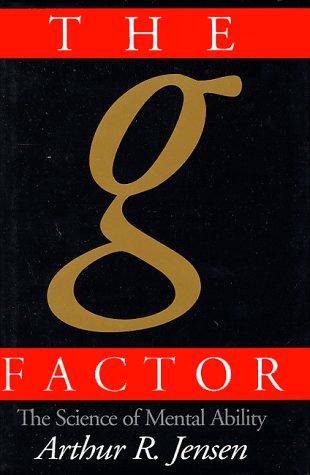
The g Factor: The Science of Mental Ability, Arthur R. Jensen, 1998
In 2006, Arthur Jensen explored the relationship between mental chronometry—the measurement of reaction times—and intelligence, further supporting the view that faster neural processing is associated with higher cognitive ability.

Clocking the Mind: Mental Chronometry and Individual Differences, Arthur R. Jensen, 2006
10. James Watson’s Courage
In 2007, James Watson, Nobel Prize laureate in Medicine for his co-discovery of the double-helix structure of DNA and one of the most prominent scientific figures of the 20th century, made headlines with a public statement.
In an interview with The Sunday Times, Watson expressed skepticism about the future of Africa, stating: “The basic assumption behind all our development aid is that Africans have the same intelligence as Europeans, but testing says not really.”

11. Helmuth Nyborg and the Hormonal Influences
Helmuth Nyborg is Professor of Developmental Psychology at the University of Aarhus, Denmark. He particularly studied the links between hormones and intelligence and sexual differences.
In 2005, he published an article in the journal Personality and Individual Differences entitled “Sex-related differences in general intelligence, brain size and social status,” in which he points out the existence of a sexual difference of 5 points in IQ to the advantage of men. Lynn had already demonstrated this difference, showing that this slight masculine cognitive advantage was the mere theoretical consequence of the larger male brain and the correlation of 0.45 between cranial capacity and general intelligence.

In 2012, Helmuth Nyborg published two significant articles. The first, titled “The Decay of Western Civilization: Double Relaxed Darwinian Selection”, explores the theme of intellectual decline in Western societies. Nyborg argues that this deterioration is occurring in parallel with the demographic growth of Afro-Maghreb populations in Europe. He attributes this trend to a weakening of natural selection pressures, which leads to a decline in cognitive and behavioral traits essential for maintaining advanced civilizations.
In a second article, “Migratory selection for inversely related covariant T—and IQ-Nexus traits: Testing the IQ/T-Geo-Climatic-Origin theory by the General Trait Covariance model,” Nyborg points to the existence of racial differences in the secretion of various hormones, including testosterone, and the reverse link found between this hormone and IQ.
12. Linda Gottfredson and the Social Importance of Intelligence Variations
Linda Gottfredson (Ph.D., professor at the University of Delaware) is an American sociologist and psychologist who broke with the recognition of the importance of intelligence in professional performance and the importance of race differences in terms of ‘intelligence.

It was at Linda Gottfredson’s initiative that “Mainstream Science on Intelligence,” signed by all the major names in the field of intelligence (Raven, Cattell, Flynn, Rushton), was published in the Wall Street Journal.
Mean IQ per profession (percentile 10, 25, 50, 75, and 90 marked).
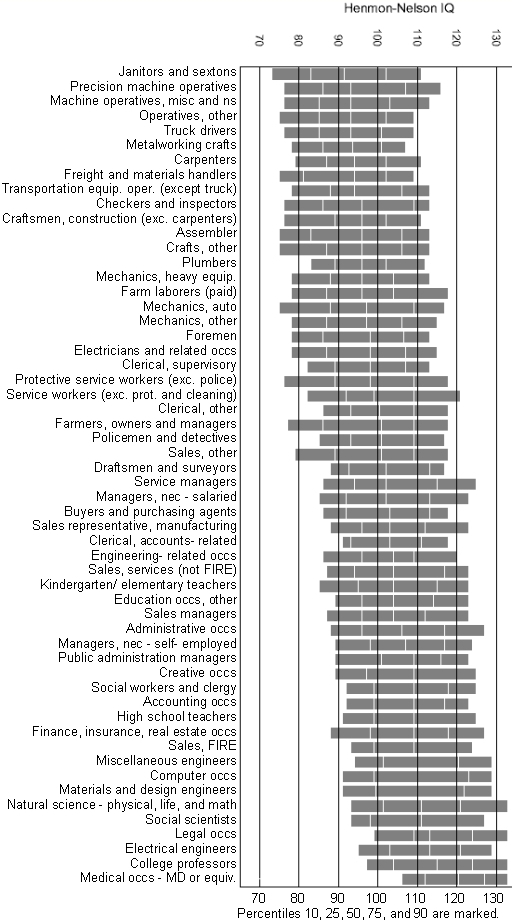
Some studies and presentations (PDF)…
“Resolute ignorance on race and Rushton” Gottfredson, Linda (2013) Personality and Individual Differences 55, 218–223.
“Présentation succinte du facteur g” Gottfredson Linda (2013) International Society for Intelligence Research, Melbourne, Australia.
“The sociology of biological intelligence” Gottfredson, Linda (2011), Hans J. Eysenck Lecture, International Society for the Study of Individual Differences, London.
13. Robert Plomin and the Emergence of GWAS Scores
Robert Plomin (PhD, professor at King’s College London) is one of the most cited psychologists of the 20th century.
He won the Dobzhansky Memorial Award (2002; Behavior Genetics Association), the William James Fellow Award (2004; Association for Psychological Science), and the Lifetime Achievement Award (2011; International Society for Intelligence Research). Plomin is first and foremost known for conducting the most comprehensive studies on identical twins and the most important genome-wide association studies (GWAS) on intelligence to date. These studies have led to the discovery of more than 1,000 genes involved in general intelligence (g or IQ).

The GWAS study, published in Nature in 2018, is a significant step. For the first time, a significant portion of a person’s intelligence can be predicted by their genome from birth. The IQ estimation is obtained by calculating a “polygenic score” based on the effect (positive or negative) of the different alleles related to intelligence. One of the surprises in these GWAS studies on intelligence was the small effect of individual alleles. It was not expected to find so many genes involved in intelligence, each having a very small individual effect (less than 1 IQ point).
As might be expected, the frequency of these alleles that increase intelligence parallels the racial IQ hierarchy. East Asians have the highest frequency of alleles for high intelligence, followed by Europeans. Africans have the lowest frequencies of these alleles.
This confirms the first results of the racial differences in allelic frequencies obtained by Piffer in 2015.
These polygenic scores for intelligence also open the way to embryonic selection.
Genome-wide association meta-analysis in 269,867 individuals identified new genetic and functional links to intelligence. Nature Genetics, 50, pages 912-919 (2018).
In October 2018, he published “Blueprint: How DNA Makes Us Who We Are,” in which Plomin explains the fundamental importance of DNA in intelligence and personality, as well as the limited impact of family and socio-educational environment on these factors. It shows how GWAS scores will reliably predict someone’s personality and intelligence from birth through genetic analysis.

14. Emil Kirkegaard, Yong, Gifted, Workaholic… Future is Assured
Emil Kirkegaard (born in 1989) is a young Danish, a former student of Helmuth Nyborg at Aarhus University. Brilliant hands-on, he is passionate about intelligence and differential psychology. He is recruited by the Ulster Institute for Social Research. In just a few years of activity, he already has a hundred publications to his credit in major journals, all open-source, dealing with national variations in intelligence, racial differences, sexual, social importance of intelligence (Kirkegaard develops the factor S, equivalent for the social factor g intelligence) or the impact of immigration.
 Emil Kirkegaard and James Flynn at the International Society for Intelligence Research (ISIR), 2017.
Emil Kirkegaard and James Flynn at the International Society for Intelligence Research (ISIR), 2017.
Follow Emil Kirkegaard on Twitter
Like many scholars who have studied intelligence and racial or sexual differences, Emil Kirkegaard has suffered the animosity of many egalitarian ideologues and different media.

